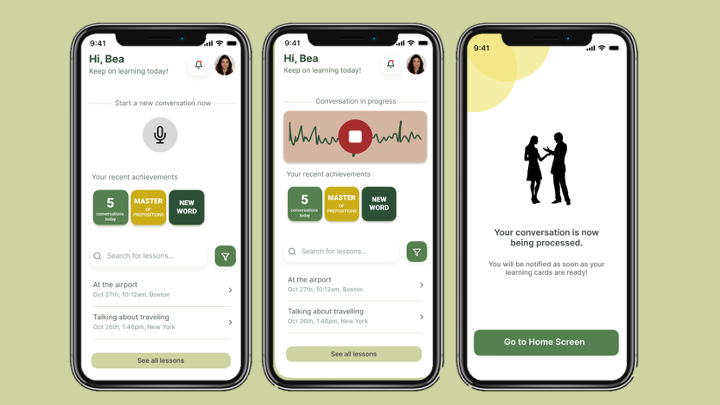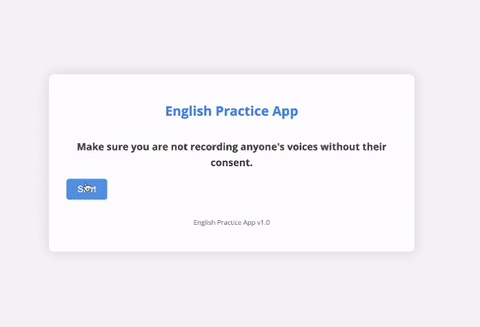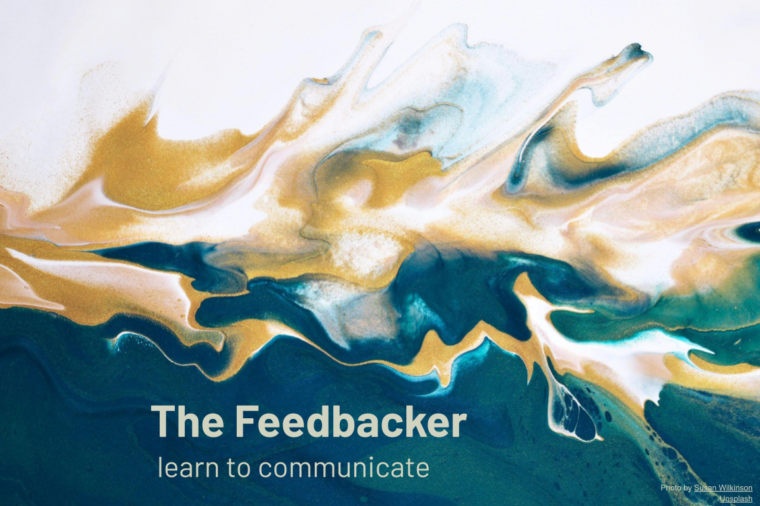The problem
How do you go from being “good enough” in English to truly mastering it? Many language learners reach a plateau, where communication is possible but fluency and nuance are still lacking. It’s hard to find another skill that people practice so frequently yet still feel the need to improve such as communication. The irony is that for the large population of non-native speakers in the U.S., every day offers ample opportunities to speak English, yet these interactions yield minimal learning. Once someone reaches a functional level of proficiency, there’s less natural motivation to refine further because they can already communicate well enough to get by.
Advancing from “good enough” to fluent is often harder than achieving the initial stages of learning. This advanced stage requires breaking ingrained habits rather than acquiring new knowledge, which is a different and more challenging learning process. Conventional language-learning tools don’t address these specific needs, and personalized coaching, while effective, is costly and difficult to integrate into a busy schedule.
In today’s world, where lifelong learning and effective communication are essential, there is a need for a tool that makes progress attainable in real-life interactions. The Feedbacker is an in-the-moment learning solution that transforms everyday conversations into personalized learning experiences, providing targeted feedback that helps you reflect, unlearn, and improve with every interaction.
While I start with language learning, this technology is adaptable to a range of communication skills—from practical improvements like reducing filler words and refining speech speed, to more nuanced areas like enhancing nonviolent communication. Imagine having a communication coach with you, ready to guide you in every conversation you choose, making each interaction an opportunity to grow.
The product
The Feedbacker is designed for individuals who’ve mastered the basics of English yet struggle to reach the level of fluency and ease that characterizes true proficiency. Imagine an international student or professional who can communicate well enough in English but faces subtle language barriers in expressing themselves naturally or confidently in professional settings, like job interviews or meetings. In these moments, even minor language errors or non-native phrases can impact first impressions and affect how one’s communication is perceived.
Feedbacker can be used with your cellphone as a recording device, or with a specific discreet recorder—small enough to be worn in an ear, on clothing, or as a wrist accessory—that captures only the wearer’s voice. Its lightweight design makes it easy to forget you’re even wearing it, allowing you to engage in conversations freely. The device recognizes when you’re speaking and can detect language patterns such as pronunciation issues, grammatical errors, or word choices that might sound unusual to native speakers. These are often mistakes you’d recognize upon reflection but are too minor or frequent to correct in real-time, especially without disrupting the conversation.
The Feedbacker’s real value comes after the conversation ends. It compiles these subtle errors into personalized learning cards that you can review at your convenience. Each learning card addresses a specific area for improvement, presented in short, digestible formats that fit into your daily life. Whether you’re on a coffee break, waiting for a meeting, or even taking a moment in between tasks, Feedbacker turns these idle moments into productive learning experiences.
With each interaction, the Feedbacker helps you incrementally improve your communication skills, offering a pathway from “good enough” to polished proficiency. Instead of replacing the natural flow of conversation with constant corrections, it works alongside you, transforming everyday language use into a continuous, personalized learning journey.
Recording a conversation

Learning

The process
Learning as an adult often centers on unlearning ingrained habits rather than simply acquiring new knowledge. This challenge is especially pronounced in language learning, where subtle mistakes often go unnoticed or are only realized after the conversation has passed. To better understand users’ needs, I conducted 12 interviews and gathered survey responses to pinpoint people’s main communication issues. These responses revealed that while people are typically aware of areas they’d like to improve, they rarely take active steps to address them. This insight guided the project’s aim: to create a tool that provides targeted, non-disruptive feedback to help adults gradually build stronger communication skills.
Originally, the concept for the Feedbacker involved providing real-time feedback for both participants in a conversation. However, as I explored user feedback and practical constraints, I realized this dyadic model presented challenges. Users might feel as though the tool was allied with their partner rather than with them, potentially worsening dynamics and leading to misunderstandings or conflict. Additionally, launching the product for individual use first made it more accessible for testing and refinement, especially in early MVP stages.
To shape the Feedbacker’s development, I used a framework to analyze how technology supports communication learning across various social contexts, focusing on two dimensions: interaction frequency (high or rare) and stakes involved (high or low). This matrix helped determine where and when feedback would be most beneficial without disrupting real-time interactions.

The tool was designed with sensitivity to the flow of conversation, ensuring that feedback enhances rather than disrupts communication. Recognizing that people’s working memory and cognitive capacity are limited, Feedbacker provides brief learning “pills” organized into cards that can be easily reviewed in a few minutes. This timing allows for feedback to be embedded seamlessly throughout the day, delivered not in the moment to avoid interference, yet not delayed so much that its relevance fades.
Throughout this project, I developed two core prototypes: a visual prototype to convey the concept and gather user feedback, and a limited functional prototype to provide a firsthand experience of real-time feedback. Experiencing feedback in the moment makes a significant difference, as the impact is harder to convey through visuals alone. Balancing the precision of feedback, managing potential noise in AI models, and addressing privacy concerns were central to shaping a tool that enhances communication learning effectively and ethically.
Below you can see the initial functional prototype, created to explore the limitations and possibilities or current LLMs. When asked to record an audio, the user says “I ate much carrots today”. The system, identifying the mistakes, creates two learning cards.

The person
Communication is one of the greatest bottlenecks to collaboration, and collaboration is the key to solving today’s complex global problems. As new challenges demand fresh thinking and a blend of diverse expertise, effective communication becomes indispensable. Throughout human history, we’ve developed tools like language, gestures, and expressions to connect with each other. Now, I’m certain we can take this further by leveraging technology to strengthen our relationships and revolutionize how we interact.
I’m an engineer, with eight years of professional experience in business and data-driven software products. I’ve led intricate projects customizing technology solutions for global corporations, often translating cutting-edge technologies like AI for audiences unfamiliar with them. As the head of a vertical SaaS startup, I successfully guided it from its initial stages until its acquisition.
At Harvard, my focus is on learning organizations and on how technology can fundamentally enhance human collaboration. My research targets social feedback tools, wearables, and the intersection of natural language processing (NLP) and human-computer interaction (HCI). This work is the foundation of my mission: designing tools that enable people to connect more deeply, grow more effectively, and collaborate more powerfully. I am fully committed to building solutions that redefine how we communicate and work together, and I’m eager to bring others along on this journey.



